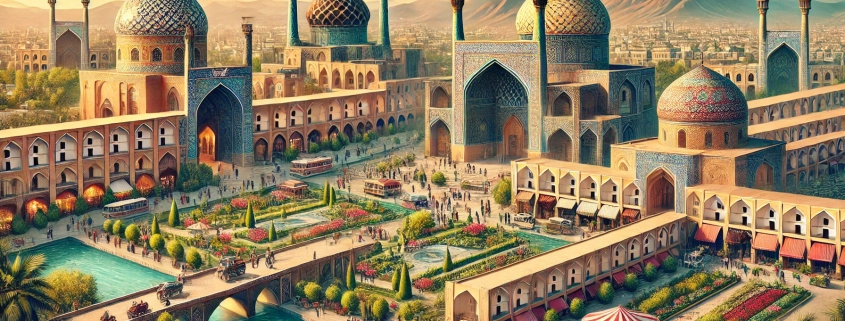Travel Guide to Isfahan: Discover the Jewel of Iran
Isfahan, often referred to as “Half of the World,” is a city rich in history, culture, and architectural marvels. Located in the heart of Iran, it offers a unique blend of ancient and modern attractions, making it a must-visit destination for travelers. This comprehensive travel guide to Isfahan will help you explore the city’s highlights, providing essential information for a memorable trip.
Getting to Isfahan
By Air
Isfahan’s Shahid Beheshti International Airport (IFN) connects the city to various domestic and international destinations. Major airlines operate regular flights from Tehran, Shiraz, and other major cities. International flights from Istanbul, Dubai, and other Middle Eastern hubs are also available.
By Train
Iran’s efficient railway network makes traveling by train a comfortable option. The Isfahan Railway Station is well-connected to Tehran, Shiraz, and Mashhad, offering scenic journeys through the Iranian countryside.
By Bus
Long-distance buses are an affordable and popular way to travel in Iran. The Kaveh and Sofeh bus terminals in Isfahan serve routes from major cities, with both VIP and standard options available.
Where to Stay in Isfahan
Luxury Hotels
- Abbasi Hotel: Housed in a 300-year-old caravanserai, this hotel offers a luxurious stay with a blend of traditional Persian architecture and modern amenities.
- Kowsar Hotel: Located near the Zayanderud River, it provides stunning views and top-notch facilities.
Mid-Range Hotels
- Setareh Hotel: A comfortable and affordable option, close to major attractions like Naqsh-e Jahan Square.
- Piroozy Hotel: Known for its excellent service and convenient location.
Budget Accommodations
- Mahbibi Hostel: A popular choice for backpackers, offering a friendly atmosphere and clean facilities.
- Iran Hotel: A budget-friendly option with basic amenities and a central location.
Top Attractions in Isfahan
Naqsh-e Jahan Square
This UNESCO World Heritage site is one of the largest city squares in the world. Surrounded by stunning architectural masterpieces, it includes:
- Imam Mosque: Renowned for its magnificent tile work and grand dome.
- Sheikh Lotfollah Mosque: A smaller, more intimate mosque with exquisite interior designs.
- Ali Qapu Palace: A six-story palace with impressive frescoes and a music room.
- Qeysarieh Bazaar: A vibrant market where you can buy Persian handicrafts, carpets, and souvenirs.
Si-o-se-pol and Khaju Bridges
The Zayanderud River is adorned with historic bridges, with Si-o-se-pol (the Bridge of 33 Arches) and Khaju Bridge being the most famous. These bridges are architectural wonders, especially beautiful when illuminated at night.
Chehel Sotoun Palace
Also known as the Palace of Forty Columns, Chehel Sotoun is set in a lush garden and features stunning frescoes and mirror work. It was used for royal receptions and ceremonies.
Vank Cathedral
Located in the Armenian quarter of Jolfa, Vank Cathedral is a beautiful example of Armenian-Iranian architecture. The interior is adorned with frescoes depicting biblical scenes.
Jameh Mosque of Isfahan
This grand mosque is one of the oldest in Iran, showcasing a blend of different architectural styles from various Islamic periods. It’s a living museum of Iranian architecture.
Cultural Experiences
Persian Gardens
Isfahan is home to several beautiful Persian gardens, such as Hasht Behesht and Bagh-e Bolbol. These gardens are perfect for a leisurely stroll and offer a glimpse into traditional Persian landscape design.
Traditional Persian Music
Isfahan has a rich musical heritage. Attend a traditional music performance at one of the city’s cultural centers or enjoy live music at local teahouses.
Persian Cuisine
No visit to Isfahan is complete without indulging in its culinary delights. Must-try dishes include:
- Beryani: A savory dish made of minced lamb, served with flatbread.
- Fesenjan: A flavorful stew made with pomegranate paste and walnuts.
- Gaz: A nougat-like sweet, often flavored with rose water and pistachios.
Shopping in Isfahan
Handicrafts
Isfahan is famous for its intricate handicrafts. The Qeysarieh Bazaar and Armenian quarter are great places to shop for:
- Minakari (Enamel Work): Beautifully decorated plates and vases.
- Khatamkari (Marquetry): Delicate inlaid work on boxes and frames.
- Persian Carpets: Exquisite handwoven carpets and rugs.
Modern Shopping
For a more contemporary shopping experience, visit the City Center Mall, which offers a range of international and local brands, a food court, and entertainment options.
Practical Tips for Travelers
Language
While Persian (Farsi) is the official language, many people in Isfahan speak basic English, especially in tourist areas. Learning a few Persian phrases can enhance your experience.
Currency
The official currency is the Iranian Rial (IRR). It’s advisable to carry cash, as credit cards are not widely accepted due to international sanctions. Money exchange offices and banks offer currency exchange services.
Dress Code
Iran has a dress code that visitors must respect. Women are required to wear a headscarf and modest clothing, while men should avoid shorts and sleeveless tops.
Safety
Isfahan is generally safe for tourists. However, it’s always wise to stay alert and follow common travel safety practices, such as avoiding isolated areas at night and keeping an eye on your belongings.
Conclusion
Isfahan is a city that captivates visitors with its blend of historical splendor and modern vibrancy. From its majestic mosques and palaces to its bustling bazaars and serene gardens, Isfahan offers a rich tapestry of experiences. This travel guide to Isfahan is designed to help you navigate the city and make the most of your visit, ensuring you leave with unforgettable memories. Whether you’re a history enthusiast, a culture lover, or simply seeking a unique travel adventure, Isfahan is a destination that promises to enchant and inspire.




Leave a Reply
Want to join the discussion?Feel free to contribute!